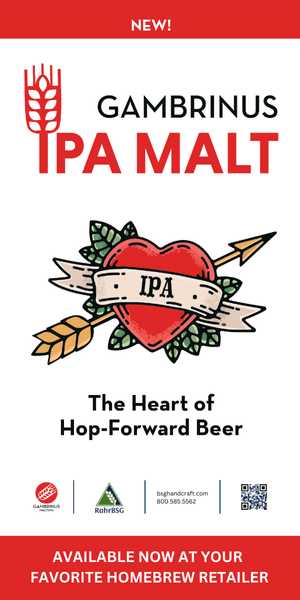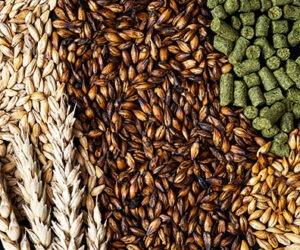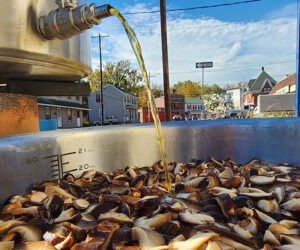Brewing Sugars for Modern Beers
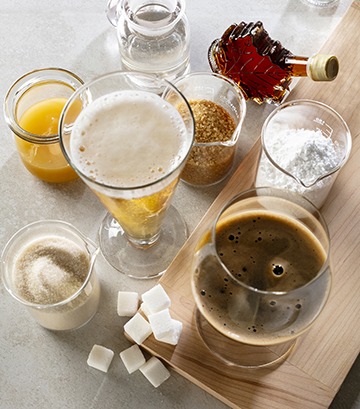
Many years ago, when I began homebrewing and a quest to brew beers similar to those created in the Trappist tradition, one common thread that became apparent the more I read about these renowned styles was their inclusion of Belgian candi sugar. For a long time, this was only spoken about in the depths of homebrew clubs. The thought of using additional sugar, outside of what is brought to us by our grain, was seen by much of the larger craft beer-loving public as taboo. It was too closely related to the way that mass-produced lagers are made. A cheat code of sorts.
The reality was that for centuries brewers had gone beyond relying solely on malt to create beer full of flavor, using various sugars to increase the original gravity in order to achieve exactly the beer that they were setting out to create. Malt is very finicky. Every mash and resulting beer is a mix of an intricate process that requires for every step to be hit in the right stages. And they were able to fine-tune those stages; but malt was not as refined as we have now. So, the use of added sugar helped to create a beer exactly as the brewer intended. And that tradition continued. Even as malt improved, new styles emerged that could only exist with the use of brewing sugar, even if that use of sugar wasn’t widely discussed.
The fun part is that brewing sugar isn’t taboo anymore; however, its many uses are misunderstood by many brewers and consumers. As brewers, sugars should be viewed as a tool to boost fermentables, lighten body, improve drinkability, and, at times, even build upon a beer’s flavor. In some cases, the impact to the flavor profile can be the primary reason we add sugar and the increase in gravity is secondary, yet must still be accounted for.
How and why to use sugar in your brewing is the basis of this article.
Brewing Sugar and Why we Use It
Brewing sugar and its entire existence is linked back to European brewing culture. The primary source for brewing with sugar that many of us brewers use as guidance is Belgian Trappist brewing. The use of candi sugar and syrups has been used for nearly a century by Belgian Trappist brewers. Where the modern American brewing culture really came into existence is with the advent of what we now call American light lager. How do you make a beer dry and flavorful? Rice and corn were the answer. Corn gave us the so-called why. It is widely available and gave a great mouthfeel to the direction of beer during the 1960s and 70s. The how was rice, which is a starch that can be converted to sugar. Though both were widely available and used pre-Prohibition; it wasn’t until the macro-lager movement of the time that they took such a prevalent place in brewers’ minds around the world as the style of light lager spread from continent to continent. Adjuncts were (and still are) used to dilute the high protein content of North American barley. Breeding programs have greatly improved today’s barley, but the original reasons for adjunct use relate to improving beer flavor and colloidal stability.
As American craft beer culture continued to gain traction during the 90s, brewers began to use various sugars in their beer to recreate classic styles, particularly those of Belgian influence. You can look at the likes of Steven Pauwels (Boulevard Brewing) and Tomme Arthur (Pizza Port/Port Brewing/The Lost Abbey) for helping to start the craze for brewing sugars in and around the late 90s. For more modern craft brewing styles, it wasn’t until a little article that the legendary Russian River Owner/Brewmaster Vinnie Cilurzo wrote explaining how to make double IPA that our world of brewing sugars was changed. That corn sugar, dextrose, was being used to make an IPA that was upwards of 8% ABV yet drying out and coming to a final gravity that was recognized as normal was eye-opening to many brewers entering the craft brewing scene at the time. Sugar was being used to build ABV and character into the beer. The sheer dryness from the sugar was the character. Crisp, clean, and hoppy, the beers created by Russian River helped push the stigma of using brewing sugars in beer out of brewers’ minds and into a place
of acceptance. Brewing sugars have now become so ingrained into the culture that there is no taboo talk.
Most sugars should be added on the hot side for the fear of refermentation after the beer is finished. There are a couple that we can also give life to as a tertiary sugar; ones that finish the beer with flavor, add a residual sweetness that rounds out the beer, and generally brings the beer back to the original concept.
So let’s now dig into some of the most recognized sugars being used today and the best way to utilize them in your homebrews.
Types of Brewing Sugar and Their Use
Belgian Candi Sugar
Used extensively by the Trappist brewers of Belgium; candi sugar is generally made from beet sugar (sucrose) that is heated and cooled repeatedly to different depths of color and flavor.
It is available in rock or syrup form from a range of light to dark. The light will add nearly no color and a very minimal flavor component to your beers. Amber and brown candi sugar adds notes of mild dark fruit and some molasses character while adding some color to a beer. Dark candi sugar will add deep molasses, raisin, and chocolate character to a beer. It will also add a large amount of color.
The range of light to dark (whether rock or syrup) will also have an impact on fermentation character. The lighter versions of candi sugar help dry out the beers they are used in. As you progress to the amber and dark versions you see much less drying out from the sugar; yet a significant flavor component on top of the added color. Using amber and dark candi sugar is one of my favorite additions to imperial-strength beers, but also needs to be tempered to allow for a proper fermentation. Used properly and in the right proportions — Belgian influenced or not — you can make use of it to create beautiful beers of nearly
any style.
Corn Sugar
Commonly known as dextrose, corn sugar has arguably become the most used sugar in brewing. Being 100% fermentable to brewer’s yeast, corn sugar adds original gravity to your wort while providing a stable fermentation profile and no flavor.
Corn sugar can fit into nearly every style of beer that you want to boost the ABV and finish drier, but has found its place in the world of IPAs, and more specifically double/imperial IPA. With its fermentability, a brewer is able to build a solid and soft malt backbone, while using dextrose to grow the gravity to a level that helps balance the alcohol and the malt presence, and really letting the hops shine. As you want to make hoppy beer that traverses the 7.5% ABV range, look at dextrose as an addition to your malt/sugar bill. Generally, shoot for 6–7% when used in your brews and look for a 1–2 °P (4–8 gravity points) pick-up from an addition that size. If you want to head to the very big IPA (9%+) don’t shy away from increasing the corn sugar to make up 10–12% of fermentables. As with all big beers, make sure you factor in extra yeast, yeast nutrient, and oxygen. But at the end of the day, done right, brewer’s yeast will eat through all sugar that dextrose throws at it.
Rice Syrup Solids
Escaping the light lager was why so many of us decided to embrace craft beer and homebrewing, but after enough time spent drinking IPAs and big, rich beers, many find their way back to seeking out these lighter beers. The hardest part about using rice is that you need to cook the rice to extract the sugars that are produced. On a home scale, utilizing a rice cooker can make that happen; but you also have the option of rice syrup solids. You can achieve the flavor, character, and dryness without the added step of cooking the rice. It brings a light flavor and a great fermentation profile finishing dry and crisp in nearly every beer that you choose to use it in.
Rice syrup solids can easily be subbed for malt as it will yield nearly the same gravity increase and fermentable sugar, while providing a solid rice character. I’ve had great success subbing up to 10% in a crushable lager. Perfect for drying out lager, but also a great experiment for your next imperial beer.
Brewers Crystals
Very similar to dextrose as it is presented, but brewers crystals do not follow through in the same way during fermentation. They definitely add sugar to the original gravity (OG) in a similar way as dextrose; however, they are specialty corn sugars with a controlled enzymatic breakdown that does not allow them to fully ferment out and thus finish much higher in the final gravity (FG) after fermentation. If you are looking to dry out the body of a beer, this is not your sugar of choice. However, it has its place.
The primary benefit of using brewers crystals in a recipe is to increase the original gravity and ABV while keeping mouthfeel and body in play. Mouthfeel and body (vs. a drier beer with many other sugars discussed) is the tradeoff when all of the sugar is not fermented out. Brewers crystals really allow a brewer to experiment with malt character and alcohol while minding the way both interplay. A balance of sorts, especially as a homebrewer.
Brewers crystals should be considered when formulating a recipe for any beer that you’d like to finish higher in gravity. Think of a mid-range alcohol beer where you don’t want to add milk sugar (lactose). Stout and porter as well as hazy IPAs are all candidates that may benefit from brewers crystals.
Maple Syrup
One of the best and worst sugars to work with is maple syrup. I say it’s one of the best because of the amazing flavor maple can add to beer styles from stouts and porters to golden ales, and many in between. It’s one of the worst because keeping that flavor around by the time the beer is through fermenting and ready to drink is easier said than done.
We always try to source from organic farmers. The farmer and the trees and the year dictate what we receive. There is no doubt that the flavor is amazing every year, but accurately measuring the sugar content upon arrival is harder; and sometimes you just have to roll the dice.
When using maple syrup, using it in the 10–12% range of total sugar for any brew works great. The biggest problem that has been seen with maple syrup is the loss of flavor through fermentation. As fermentation happens, sometimes the intricate flavors of your ingredients can get blown off in the process. Maple is very susceptible to this. With that in mind, plan to add a bit more syrup on the back end after fermentation completes. The character builds back and really helps the final iteration of your creation stand out. You will always need to watch out for refermentation when using maple syrup on the back end of the beer you create. To limit refermentation, the suggestion would be to cold crash your beer. Once crashed, transfer off the yeast cake and onto the maple syrup. Keep cold at all times once you package, and kegging (or canning) is the safer route to avoid any possibility of exploding glass bottles.
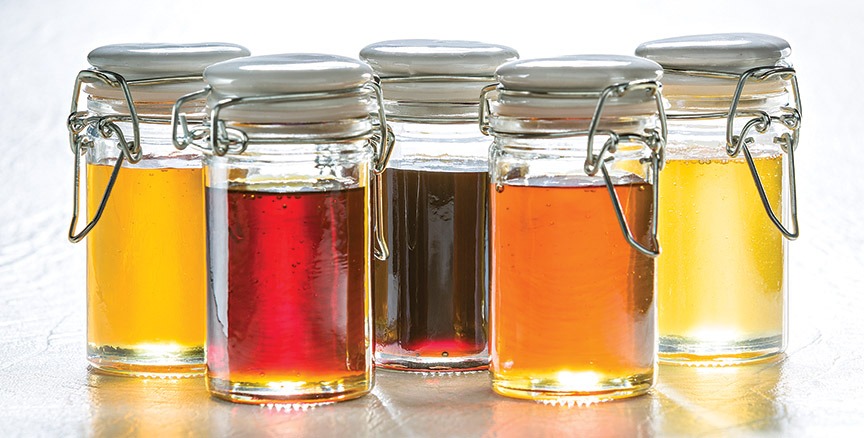
Honey
Honey is similar in many ways to maple syrup, but to its advantage the character honey imparts holds up better through fermentation. Your provider is one of the most important parts of the ingredient. Seek out honey from local or trusted producers that care about what is being created.
When honey is added has a huge impact on what it carries over to the finished beer. Using honey early in the boil will kill the character of the honey. Transferring your honey additions to late in the boil or the whirlpool will help to keep the character of your chosen honey. Adding honey half way through your fermentation can also produce astounding results with flavor and aroma, while giving you peace of mind that you won’t need to worry about refermentation. It’s a “sticky” situation, but I would highly recommend it for maximum flavor and aroma additions to your beer.
The most unique part about honey is the impact from the flowers that our bee friends pollinate from. Your finished beer will have the flavor and taste of the flower honey that you choose. We’ve extensively used both wildflower and Mexican coffee honey at Oakshire Brewing (Eugene, Oregon) and both smell and taste exactly as they are described. Think of a flower’s aroma that may complement a beer’s flavor, then find a honey to match or build your wort composition around that flavor.
Other Sugars
There are so many other sugars that a brewer can talk about. We are always seeking and trying to create. For that reason, we view ingredients as our step to progress. Don’t leave out molasses, turbinado sugar, or even fruit as an important source of sugar used to create beer. Sugars are all viable to us as brewers and finding the best way to use them is our way forward.
Beer and Sugar
Beer and sugars in a way is our next step. Our predecessors in the brewing industry decided to introduce sugars into the process and modern brewers have continued to run with it. Now we sit at the point where we get to decide what that next step is, and what the next sugar is that we can use to make the next great beer. That for everyone should be the next thought and challenge. I know it is for me.
Oakshire Brewing Co.’s A Life Beyond the Dream clone
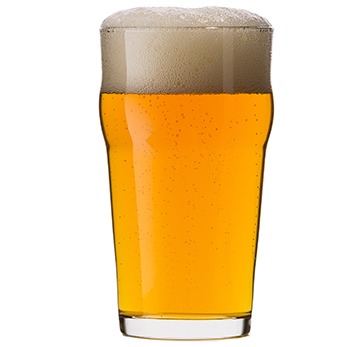
(5 gallons/19 L, all-grain)
OG = 1.094 FG = 1.014
IBU = 56 SRM = 7 ABV = 10.5%
Dextrose is used as the catalyst for the dryness of such a big beer while letting the malt balance out the huge hop load. Oakshire likes using the Incognito® hop oil (both of these varieties are available in smaller homebrew quantities) to get the resinous character while maintaining the mouthfeel for this triple IPA.
Ingredients
13.5 lbs. (6.1 kg) North American 2-row pale malt
1.2 lbs. (544 g) Weyermann CaraFoam® malt
0.6 lb. (272 g) Gambrinus honey malt
0.6 lb. (272 g) acidulated malt
2.2 lbs. (1 kg) dextrose sugar (5 min.)
10.9 AAU Herkules hops (60 min.) (0.75 oz./21 g at 14.5% alpha acids)
7 g Citra® Incognito® (0 min.)
7 g Mosaic® Incognito® (hopstand)
2 oz. (56 g) Strata® hops (hopstand)
2 oz. (56 g) Columbus hops (hopstand)
4 oz. (113 g) Columbus hops (dry hop)
2 oz. (56 g) Simcoe® CryoTM hops (dry hop)
4 oz. (113 g) Strata® hops (dry hop)
4 oz. (113 g) Nelson SauvinTM hops (dry hop)
2 oz. (56 g) Mosaic® CryoTM hops (dry hop)
1⁄2 tsp. yeast nutrients (15 min.)
Whirlfloc tablet (15 min.)
White Labs WLP001 (California Ale), Wyeast 1056 (American Ale), or SafAle US-05 yeast
3⁄4 cup corn sugar (if priming)
Step by Step
If using a liquid yeast strain, consider making a yeast starter two days prior to brew day. Treat soft or reverse osmosis brewing water with 1 tsp. calcium sulfate and 1⁄2 tsp. calcium chloride. Mash grains at 148 °F (64 °C) for 60 minutes before starting lautering process. During the sparge, add another 1⁄2 tsp. calcium sulfate directly to the kettle.
Boil the wort for a total of 60 minutes with the first hop addition going in at the start of the boil and the second addition added just after the heat is turned off at the end of the boil. Add yeast nutrients, Whirlfloc, and dextrose sugar per ingredients list. After the boil, begin whirlpool. After 10 minutes bring wort temperature down to roughly 175 °F (80 °C) and add the hopstand additions. Spin for another 10 minutes then let settle for 10 minutes before chilling wort down to yeast pitch temperature.
If using a liquid yeast strain, aerate the wort well as the high sugar environment will be hostile for yeast. Consider pitching two sachets of yeast if using a dry yeast strain. Ferment at 68 °F (20 °C) for one week or until signs of fermentation have ceased. Once settling has occurred, add the dry hops and let sit for three days. Keg and force carbonate to 2.5 v/v or bottle and prime with sugar.
Extract with grains option: Swap out the 2-row pale malt for 8 lbs. (3.6 kg) extra light dried malt extract and the acidulated malt for 1 tsp. 88% lactic acid. Add the lactic acid to 5 gallons (19 L) brewing water. Place the crushed grains into a muslin bag and steep in the brewing water as it heats up to 170 °F (77 °C). Remove the grains, allowing them to drip back into the kettle. Remove kettle from heat and stir in the dried malt extract. Once fully dissolved turn the heat back on and bring to a boil. Follow all-grain instructions for the remainder of the process, being sure to top up the fermenter to 5.25 gallons (20 L) before starting fermentation.
Oakshire Brewing Co.’s Key-Limety Kölsch
(5 gallons/19 L, all-grain)
OG = 1.046 FG = 1.008
IBU = 22 SRM = 4 ABV = 5%
Brewed to include the addition of key lime puree, this Kölsch uses a semi-traditional Kölsch grist bill along with a big helping of honey. Fermented with Kölsch yeast and finishing dry, this is a very fun one. Feel free to omit the fruit or substitute another fruit for key lime, as Oakshire has done on occasion.
Ingredients
3 lbs. (1.4 kg) Weyermann Cologne malt
2.5 lbs. (1.1 kg) Weyermann Pilsner malt
1.5 lbs. (0.68 kg) Weyermann Barke® Vienna malt
8 oz. (227 g) Weyermann CaraFoam® malt
4 oz. (113 g) acidulated malt
1.5 lbs. (0.68 kg) honey, any varietal (10 min.)
24 oz. (710 mL) key lime puree
4.3 AAU Nugget hops (60 min.) (0.33 oz./9 g at 13% alpha acids)
5.6 AAU SultanaTM hops (10 min.) (0.4 oz./11 g at 14% alpha acids)
0.4 oz. (11 g) LemondropTM hops (0 min.)
Whirlfloc tablet (15 min.)
1⁄4 tsp. yeast nutrients (15 min.)
White Labs WLP029 (German Ale), Wyeast 2565 (Kölsch), or SafAle K-97 yeast
3⁄4 cup corn sugar (if priming)
Step by Step
If using soft or reverse osmosis brewing water, add 1⁄2 tsp. 85% phosphoric acid, 3⁄4 tsp. calcium chloride, and 1⁄4 tsp. calcium sulfate. Mash the grains at 152 °F (67 °C) for 60 minutes before beginning the lauter process. Add 1⁄2 tsp. 88% lactic acid directly to the kettle. Bring wort to a boil and boil for 60 minutes adding the hops, honey, kettle fining agent (Whirlfloc), and yeast nutrients per the ingredients list.
At the end of the boil, turn off the heat and add the final hop addition. Create a whirlpool then let settle for 10 minutes. Chill the wort down to yeast pitch temperature then pitch the yeast. Ferment at 64 °F (18 °C). After peak fermentation has been reached and fermentation slows noticeably, add the lime puree. Raise temperature to 68 °F (20 °C) and hold for 2–3 days. Once terminal gravity has stabilized, drop the temperature to 32–40 °F (0–4 °C) for a one- to two-week lagering period. Keg and force carbonate to 2.5 v/v or bottle and prime with sugar.
Extract with grains option: Replace the Cologne, Pilsner, and Vienna base malts with 3.5 lbs. (1.6 kg) Pilsen dried malt extract and 0.5 lb. (230 g) Munich dried malt extract. Replace the acidulated malt with 1⁄2 tsp. 88% lactic acid. With 5 gallons (19 L) of water in the brew kettle, add the lactic acid. Steep the crushed CaraFoam® malt in a small muslin bag as the water heats up to 170 °F (77 °C). Remove the grains, allowing liquid to drip back into the kettle.
Off heat, stir in the dried malt extract. Once fully dissolved turn the heat back on and bring to a boil. Follow all-grain instructions for the remainder of the process, being sure to top up the fermenter to 5.25 gallons (20 L) before starting fermentation.
